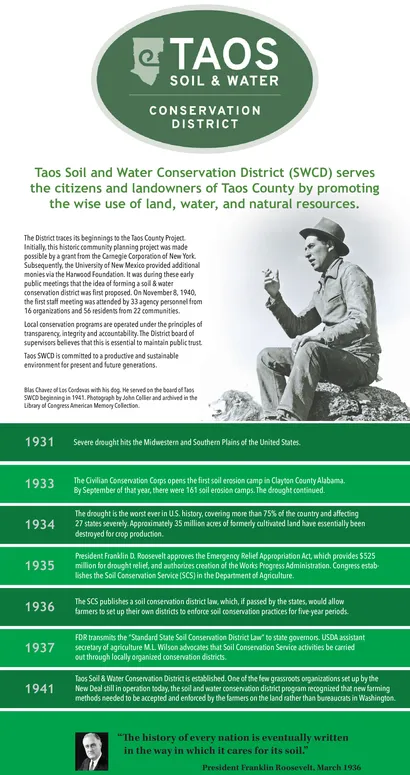Advertisement

-
Published Date
October 13, 2021This ad was originally published on this date and may contain an offer that is no longer valid. To learn more about this business and its most recent offers, click here.
Ad Text
e TAOS SOIL & WATER CONSERVATION DISTRICT Taos Soil and Water Conservation District (SWCD) serves the citizens and landowners of Taos County by promoting the wise use of land, water, and natural resources. The District traces its beginnings to the Taos County Project. Initially, this historic community planning project was made possible by a grant from the Cantegie Corporation of New York. Subsequently, the University of New Mexico provided additional monies via the Hanwood Foundation. It was during these early public meetings that the idea of forming a sol & water conservation district was finst proposed. On November 8, 1940, the first staff meeting was attended by 33 agency personnel from 16 organizations and 56 residents from 22 communities. Local conservation programs are operated under the principles of transparency, integrity and accountability. The District board of supervisors believes that this is essential to maintain public trust Taos SWCD is committed to a productive and sustainable envitonment for present and future generations. Blas Chavez of Les Condovan with his dog. He served en the board of faes SWCD beginning in 1941. Photograph by John Collier and ardhived in the Libany of Congress American Memory Collection. 1931 Severe drought hits the Midwestern and Southern Plains of the United States. 1933 The Civilian Conservation Corps opens the first soll eresion camp in Clayton County Alabama. By September of that year, there were 161 soil erosion camps. The drought continued. The drought is the worst ever in US. history, covering more than 75% of the country and affecting 27 states severely. Approsimately 35 million acres of formerly cultivated land have essentially been destroyed for crop production. 1934 President Franklin D. Roosevelt approves the Emergency Reliel Appropriation Act, which provides $525 million for drought relief, and authorizes creation of the Works Progress Administration. Congress estab- Iishes the Soil Conservation Service (SCS) in the Department of Agriculture, 1935 The SCS publishes a soil conservation district law, which, if passed by the states, would allow famers to set up their own districts to enforce soil conservation practices for five year periods. 1936 FDR transmits the "Standard State Soil Conservation District Law" to state governors. USDA assistant secretary of agriculture ML. Wilson advocates that Soil Conservation Service activities be carried out through locally onganized conservation districts. 1937 Taos Sol & Water Conservation District is established. One of the few grassroots organizations set up by the New Deal still in operation today, the soil and water conservation district program recognized that new farming methods needed to be accepted and enforced by the famers on the land rather than bureaucats in Washington. 1941 "The history of every nation is eventually written in the way in which it cares for its soil." President Franklin Roosevelt. March 1936 e TAOS SOIL & WATER CONSERVATION DISTRICT Taos Soil and Water Conservation District (SWCD) serves the citizens and landowners of Taos County by promoting the wise use of land, water, and natural resources. The District traces its beginnings to the Taos County Project. Initially, this historic community planning project was made possible by a grant from the Cantegie Corporation of New York. Subsequently, the University of New Mexico provided additional monies via the Hanwood Foundation. It was during these early public meetings that the idea of forming a sol & water conservation district was finst proposed. On November 8, 1940, the first staff meeting was attended by 33 agency personnel from 16 organizations and 56 residents from 22 communities. Local conservation programs are operated under the principles of transparency, integrity and accountability. The District board of supervisors believes that this is essential to maintain public trust Taos SWCD is committed to a productive and sustainable envitonment for present and future generations. Blas Chavez of Les Condovan with his dog. He served en the board of faes SWCD beginning in 1941. Photograph by John Collier and ardhived in the Libany of Congress American Memory Collection. 1931 Severe drought hits the Midwestern and Southern Plains of the United States. 1933 The Civilian Conservation Corps opens the first soll eresion camp in Clayton County Alabama. By September of that year, there were 161 soil erosion camps. The drought continued. The drought is the worst ever in US. history, covering more than 75% of the country and affecting 27 states severely. Approsimately 35 million acres of formerly cultivated land have essentially been destroyed for crop production. 1934 President Franklin D. Roosevelt approves the Emergency Reliel Appropriation Act, which provides $525 million for drought relief, and authorizes creation of the Works Progress Administration. Congress estab- Iishes the Soil Conservation Service (SCS) in the Department of Agriculture, 1935 The SCS publishes a soil conservation district law, which, if passed by the states, would allow famers to set up their own districts to enforce soil conservation practices for five year periods. 1936 FDR transmits the "Standard State Soil Conservation District Law" to state governors. USDA assistant secretary of agriculture ML. Wilson advocates that Soil Conservation Service activities be carried out through locally onganized conservation districts. 1937 Taos Sol & Water Conservation District is established. One of the few grassroots organizations set up by the New Deal still in operation today, the soil and water conservation district program recognized that new farming methods needed to be accepted and enforced by the famers on the land rather than bureaucats in Washington. 1941 "The history of every nation is eventually written in the way in which it cares for its soil." President Franklin Roosevelt. March 1936
